www.skyandtelescope.org copy pastes.
Moderator: Community Team
Re: Astronomy!
Except by the time you get it across the border, between exchange rate, duty and shipping it's not going to be a good deal anymore.
That Jupiter moon eclipse should be tonight, I would guess EDT is eastern daylight. Isn't skyandtelescope.org an American magazine?
The link works for me.
It's good to see you have clear skys. It is cloudy and snowed here on Wednesday morning.
https://cam01.sci.ucalgary.ca/AllSkyCam ... tImage.JPG
update:
I found one in Ontario, 500 bucks Canadian plus shipping.
https://khanscope.com/products/sky-watc ... ope-s11600
That Jupiter moon eclipse should be tonight, I would guess EDT is eastern daylight. Isn't skyandtelescope.org an American magazine?
The link works for me.
It's good to see you have clear skys. It is cloudy and snowed here on Wednesday morning.
https://cam01.sci.ucalgary.ca/AllSkyCam ... tImage.JPG
update:
I found one in Ontario, 500 bucks Canadian plus shipping.
https://khanscope.com/products/sky-watc ... ope-s11600
-

 2dimes
2dimes
- Posts: 12964
- Joined: Wed May 31, 2006 1:08 pm
- Location: Pepperoni Hug Spot.














Re: Astronomy!
https://www.amazon.com/Orion-8945-SkyQuest-Dobsonian-Telescope/dp/B001DDW9V6/ref=asc_df_B001DDW9V6/?tag=hyprod-20&linkCode=df0&hvadid=309836137809&hvpos=&hvnetw=g&hvrand=4673854085630297902&hvpone=&hvptwo=&hvqmt=&hvdev=m&hvdvcmdl=&hvlocint=&hvlocphy=9014046&hvtargid=pla-568705319654&psc=1
Double the light gathering ability for $26 canadian
If it was up to me, you'd have your own hubble
Double the light gathering ability for $26 canadian
If it was up to me, you'd have your own hubble

-

 WILLIAMS5232
WILLIAMS5232
- Posts: 1838
- Joined: Sun Aug 16, 2009 4:22 pm
- Location: houston texas






















Re: Astronomy!
Yeah, a nice ten foot mirror aught to do the trick.
It's snowing here so...
It's snowing here so...
-

 2dimes
2dimes
- Posts: 12964
- Joined: Wed May 31, 2006 1:08 pm
- Location: Pepperoni Hug Spot.














Re: Astronomy!
Watch the Moon Journey Across the Winter Hexagon
About once a month this winter, we can watch the Moon take a four-day journey across a field of stars termed the "Winter Hexagon."
Some of the most amazing things about watching the skies are the chances we get to see the universe in action. Even if individual objects seem steady and unchanging, we can pick up on the delicate rhythms and subtle dances between them.
https://skyandtelescope.org/observing/
HOW THE MOON CROSSES THE WINTER HEXAGON
At the start of November, we can watch this dance in the context of the Winter Hexagon, as winter’s celebrated stars file back into the night, like old friends arriving at an end-of-the-year party.
While that happens, there’s a little extra magic. Not only do we see the brilliant lights of Orion, Gemini, and Taurus again, but we also see the Moon dancing through these constellations.
The Winter Hexagon, you may remember, is a giant asterism of six first-magnitude stars, which ride across the night sky from mid-fall until the last of them fades into the western dusk in the spring. It's a fun party trick to run counterclockwise around the Hexagon and rattle off the names of all its stars: Capella, Castor, Pollux, Procyon, Sirius, Rigel and Aldebaran. (Note that Castor isn't quite a first-magnitude star; still, it’s nearly as bright as Pollux. If we add it in, it gives the names of the Hexagon's stars a pleasing, bouncy rhythm when you say them aloud. Give it a try; you’ll see.)
ALSO:
Sky This Month: Planets shine morning and night
Here's what to look for in the sky in November!
While that happens, there’s a little extra magic. Not only do we see the brilliant lights of Orion, Gemini, and Taurus again, but we also see the Moon dancing through these constellations.
The Winter Hexagon, you may remember, is a giant asterism of six first-magnitude stars, which ride across the night sky from mid-fall until the last of them fades into the western dusk in the spring. It's a fun party trick to run counterclockwise around the Hexagon and rattle off the names of all its stars: Capella, Castor, Pollux, Procyon, Sirius, Rigel and Aldebaran. (Note that Castor isn't quite a first-magnitude star; still, it’s nearly as bright as Pollux. If we add it in, it gives the names of the Hexagon's stars a pleasing, bouncy rhythm when you say them aloud. Give it a try; you’ll see.)
https://astronomy.com/magazine/sky-this-month/2020/11/sky-this-month-planets-shine-morning-and-night
-

 jusplay4fun
jusplay4fun
- Posts: 7135
- Joined: Sun Jun 16, 2013 8:21 pm
- Location: Virginia






















Re: Astronomy!
For me, astronomy was something beyond comprehension. For some reason, I always thought about science fiction books and films. But gradually I began to read articles about missile launches, about their design. So I found the aerospace company (UK), on whose website there is a lot of interesting information about the possibilities of research from near-earth orbit. It's really great that today we can observe life on our planet from the sidelines. Perhaps in the near future we will change our lives for the better thanks to these observations.
MOD EDIT: Link may have been altered (TeeGee)
MOD EDIT: Link may have been altered (TeeGee)
-
 Challenger007
Challenger007
- Posts: 3
- Joined: Wed Nov 04, 2020 7:34 am
Re: Astronomy!
There's a comet in Orion currently, the sky was very clear last night and I have very little light pollution. I sat outside with my binoculars and tried to spot it, I told myself if I can make it out with my binoculars, I'd pull out my telescope. Well, I could never get an idea that I saw it.
As I was looking for it, something caught my eye, it was like how you see a star twinkle in your peripherals, after some investigation in my book, I learned it was near a star named Cursa, which is the beta star of Eridanus. Its right near Rigel which is part of Orion.
When I went to this object with my binoculars, it was very strange, the light was pulsing in rhythm like how an airplane strobe would, except it wasn't moving at all. Sometimes ill follow satellites and see them start to glimmer and flicker as they enter earths shadow and eventually disappear from sight. This was not the same. I was really baffled, I went inside to check the web for discussion but could not find anything, when I came back out to find it again after 10-20 mins, it had moved obviously, but not by much...still pulsing. It was a very bright pulse, followed by a dim pulse that kept going, it was very hard to see without the binoculars.
I went back inside again looking for more discussion on the internet and after maybe 10 mins again I came back out and could not locate it any longer
I'm not a conspiracy guy, and am not claiming anything like aliens, it was just odd. I was hoping to find some discussion on it, since there is a comet in the vicinity, I would figure im not the only person to have seen it.
As I was looking for it, something caught my eye, it was like how you see a star twinkle in your peripherals, after some investigation in my book, I learned it was near a star named Cursa, which is the beta star of Eridanus. Its right near Rigel which is part of Orion.
When I went to this object with my binoculars, it was very strange, the light was pulsing in rhythm like how an airplane strobe would, except it wasn't moving at all. Sometimes ill follow satellites and see them start to glimmer and flicker as they enter earths shadow and eventually disappear from sight. This was not the same. I was really baffled, I went inside to check the web for discussion but could not find anything, when I came back out to find it again after 10-20 mins, it had moved obviously, but not by much...still pulsing. It was a very bright pulse, followed by a dim pulse that kept going, it was very hard to see without the binoculars.
I went back inside again looking for more discussion on the internet and after maybe 10 mins again I came back out and could not locate it any longer
I'm not a conspiracy guy, and am not claiming anything like aliens, it was just odd. I was hoping to find some discussion on it, since there is a comet in the vicinity, I would figure im not the only person to have seen it.

-

 WILLIAMS5232
WILLIAMS5232
- Posts: 1838
- Joined: Sun Aug 16, 2009 4:22 pm
- Location: houston texas






















Re: Astronomy!
THIS WEEK'S SKY AT A GLANCE, NOVEMBER 13 – 21
https://skyandtelescope.org/observing/t ... r-13-21-2/
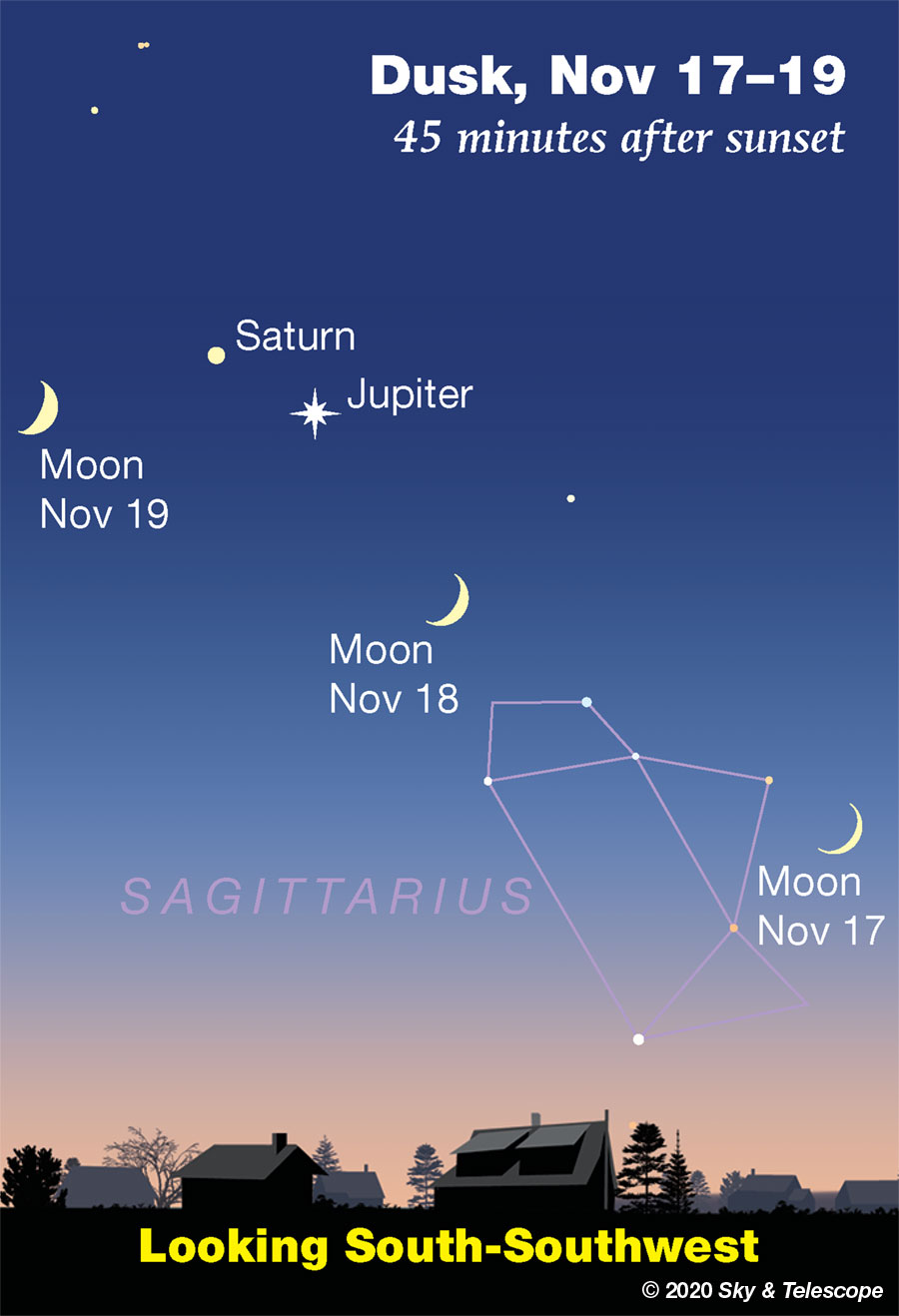
https://skyandtelescope.org/observing/t ... r-13-21-2/

TUESDAY, NOVEMBER 17
■ During twilight this evening, Saturn and Jupiter point diagonally down to the thin crescent Moon low in the southwest, as shown below. A new lunation has begun.
Left of the Moon, how many stars of the disappearing Sagittarius Teapot can you still discern? Can you get them all using binoculars?
■ Late tonight the Leonid meteor shower should be at its peak, and there's no Moon. Best time to watch: from about 3 a.m. until the beginning of Wednesday's dawn. That's when the shower's radiant point, in the Sickle of Leo, climbs high in the southeast. The Leonids have been weak in recent years, but under ideal dark-sky conditions you might count more than a dozen per hour. The numbers will be fewer under light pollution and earlier in the night. (You're guaranteed to see zero Leonids until the radiant rises, around 10 or 11 p.m.)
■ Around 8 or 9 p.m. this week, the Great Square of Pegasus stands at its level, boxy position very high toward the south. (It's straight overhead if you're as far south as Miami.) Its right (western) edge points very far down toward Fomalhaut. Its eastern edge points less directly toward Beta Ceti, less far down.
Last edited by jusplay4fun on Sat Nov 14, 2020 2:55 am, edited 1 time in total.
-

 jusplay4fun
jusplay4fun
- Posts: 7135
- Joined: Sun Jun 16, 2013 8:21 pm
- Location: Virginia






















Re: Astronomy!
More from:
THIS WEEK'S SKY AT A GLANCE, NOVEMBER 13 – 21
https://skyandtelescope.org/observing/this-weeks-sky-at-a-glance-november-13-21-2/
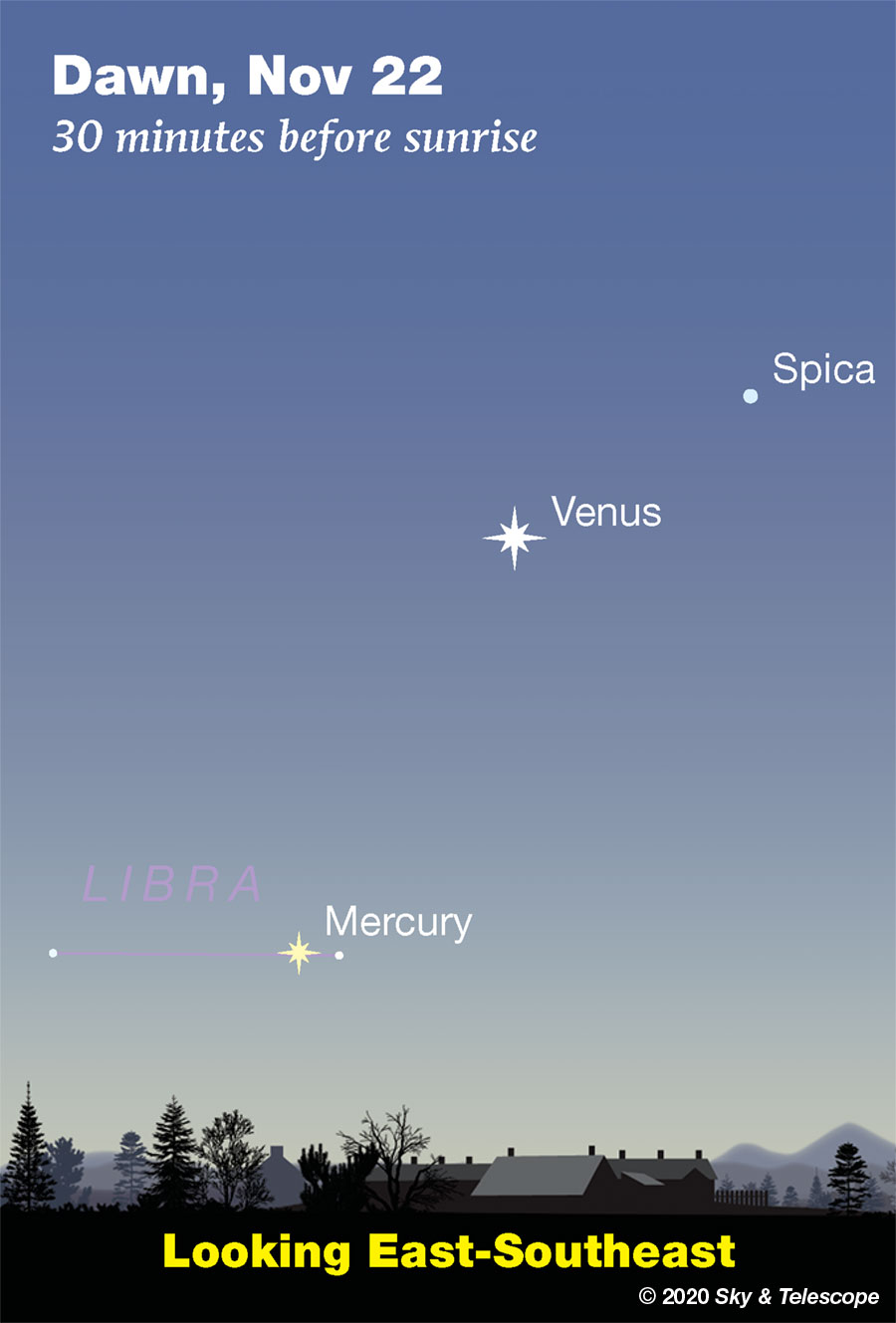
THIS WEEK'S SKY AT A GLANCE, NOVEMBER 13 – 21
https://skyandtelescope.org/observing/this-weeks-sky-at-a-glance-november-13-21-2/
SATURDAY, NOVEMBER 21
■ The bowl of the Little Dipper descends in the evening at this time of year, left or lower left of Polaris. By about 11 p.m. it hangs straight down from Polaris.
■ As dawn brightens Mercury is still nicely visible in the east-southeast. Look for it lower left of Venus as shown below. Next week it will descend from sight down to the dawn horizon.

Mercury is still in good view as dawn brightens if you have a low view to the east-southeast. The 3rd-magnitude star about 1° to Mercury's right (use binoculars!) is Alpha Librae. Look too for Beta Librae farther off to the left. The visibility of the faint objects in bright twilight is greatly exaggerated here; even Mercury, then even Venus, become difficult as day approaches.
-

 jusplay4fun
jusplay4fun
- Posts: 7135
- Joined: Sun Jun 16, 2013 8:21 pm
- Location: Virginia






















Re: Astronomy!
More observations this week in the Sky:
Observing
SKY THIS WEEK
https://astronomy.com/-/media/Images/News%20and%20Observing/News/2015/11/Leonids.jpg?mw=800
https://astronomy.com/observing
Observing
SKY THIS WEEK
https://astronomy.com/-/media/Images/News%20and%20Observing/News/2015/11/Leonids.jpg?mw=800
https://astronomy.com/observing
The Sky This Week: Catch the Leonid meteor shower
There’s a comet, a meteor shower, and much more in the sky from November 13 to 20.
-

 jusplay4fun
jusplay4fun
- Posts: 7135
- Joined: Sun Jun 16, 2013 8:21 pm
- Location: Virginia






















Re: Astronomy!
I love Jupiter!
“Life is a shipwreck, but we must not forget to sing in the lifeboats.”
― Voltaire
― Voltaire
-

 Dukasaur
Dukasaur
- Community Coordinator

- Posts: 27723
- Joined: Sat Nov 20, 2010 4:49 pm
- Location: Beautiful Niagara





























 3
3




 2
2


Re: Astronomy!
JUS 4 U, Duk, by Jove.... 
Dukasaur wrote:I love Jupiter!
-

 jusplay4fun
jusplay4fun
- Posts: 7135
- Joined: Sun Jun 16, 2013 8:21 pm
- Location: Virginia






















Re: Astronomy!
THIS WEEK'S SKY AT A GLANCE, NOVEMBER 20 – 28
TUESDAY, NOVEMBER 24
■ Mars shines about a fist-width to the upper left of the waxing gibbous Moon this evening, as shown below.
Mars has lost two thirds of the brightness it displayed around opposition in early October. But at magnitude –1.4 it's still as bright as Sirius, which will be up and shining low in the southeast after midnight. At that time, Mars will be very high in the southwest.
https://skyandtelescope.org/observing/this-weeks-sky-at-a-glance-november-20-28-2/
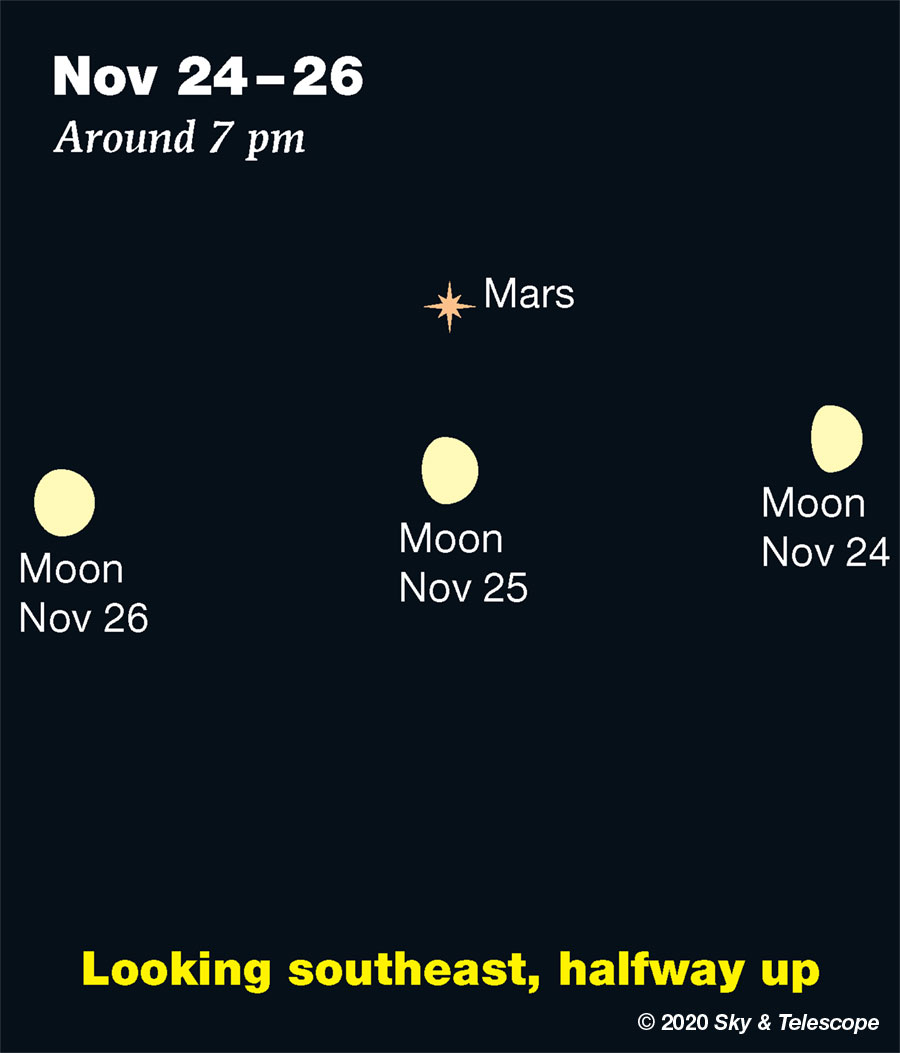
SATURDAY, NOVEMBER 21
■ First-quarter Moon (exact at 11:45 p.m.). The Moon shines between dim Aquarius and Capricornus. Look to its lower left for Fomalhaut.
■ The bowl of the Little Dipper is descending in the evening at this time of year, left or lower left of Polaris. By about 11 p.m. it hangs straight down from Polaris.
■ As dawn brightens on Sunday morning the 22nd, Mercury is still nicely visible in the east-southeast. Look for it lower left of Venus as shown below. Day by day it will descend toward the dawn horizon and out of sight.

-

 jusplay4fun
jusplay4fun
- Posts: 7135
- Joined: Sun Jun 16, 2013 8:21 pm
- Location: Virginia






















Re: Astronomy!
Tuesday, November 24
Starting an hour before sunrise, both Mercury and Venus should be easy to spot in the brightening sky. Mercury, just rising among the stars of Libra, is an easy magnitude –0.7. Venus is impossible to miss at magnitude –4. It’s sitting less than 2° from magnitude 4 Kappa (κ) Virginis and is now 10° due east of bright Spica.
https://astronomy.com/news/observing/2020/11/the-sky-this-week-from-november-20-to-27
Wednesday, November 25
The Moon passes 5° south of Mars at 3 P.M. EST. By sunset, our satellite is just 5.2° from the Red Planet. Mars remains in Pisces the Fish, while the Moon is south-southwest of the planet, just over the border in Cetus the Whale.
-

 jusplay4fun
jusplay4fun
- Posts: 7135
- Joined: Sun Jun 16, 2013 8:21 pm
- Location: Virginia






















Re: Astronomy!
Jupiter and Saturn fashion a 21st-century version of the “Christmas Star” when they pair up on December 21st, the winter solstice. That evening they’ll be closest in nearly 400 years.
While we're all trying our best to keep our distance from one another during the current pandemic, Jupiter and Saturn are defiantly doing exactly the opposite. Since September they've been drawing closer and closer as they inch toward their Great Conjunction on Monday, December 21st. That night the gas giants will shine shoulder to shoulder just 0.1° apart (1/5th the apparent diameter of the full Moon) in their closest conjunction since July 1623.
Every 20 years, Jupiter, the closer and faster planet, laps slower Saturn and the two pair up briefly in a Great Conjunction. The last occurred on May 31, 2000, when they stood 1.2° apart low in the solar glare at dawn.
https://skyandtelescope.org/astronomy-news/jupiter-and-saturn-embrace-in-solstice-conjunction/
Bright Jupiter and Saturn are closer together now (1.8° apart) than modest, 3rd-magnitude Alpha and Beta Capricorni are above them (2.3° apart), as shown below. Wait for full dark to catch the faint stars. Jupiter and Saturn are closing toward their record-breaking conjunction on December 21st, when they will appear only 0.1° apart. That's about the width of a toothpick at arm's length!
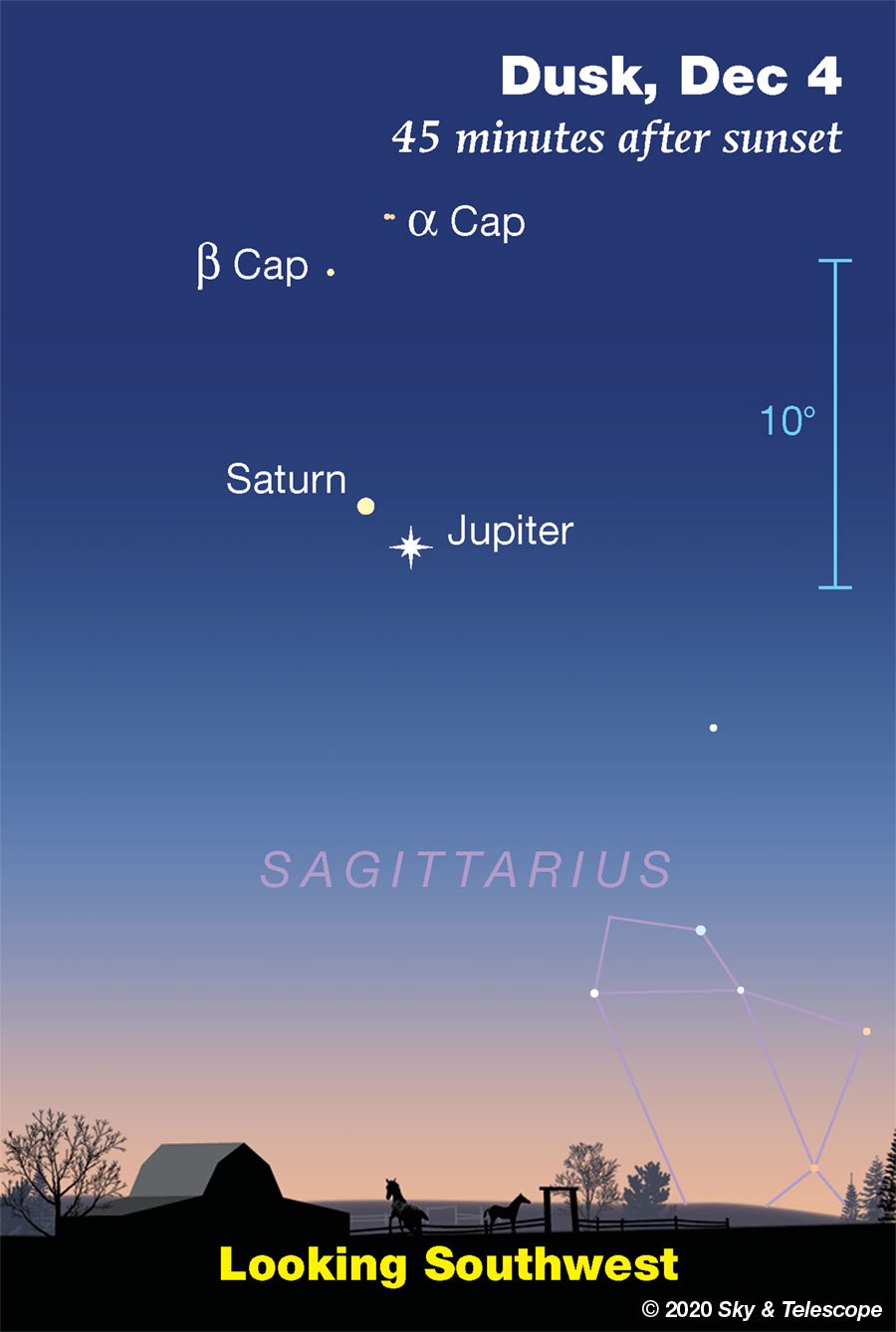
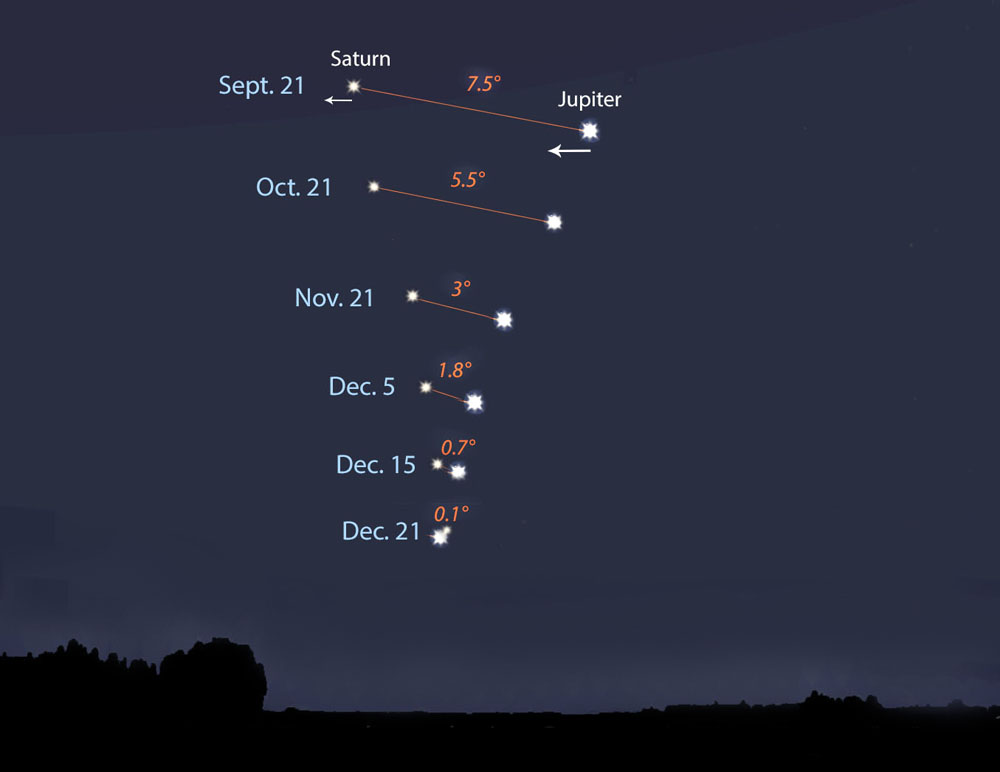
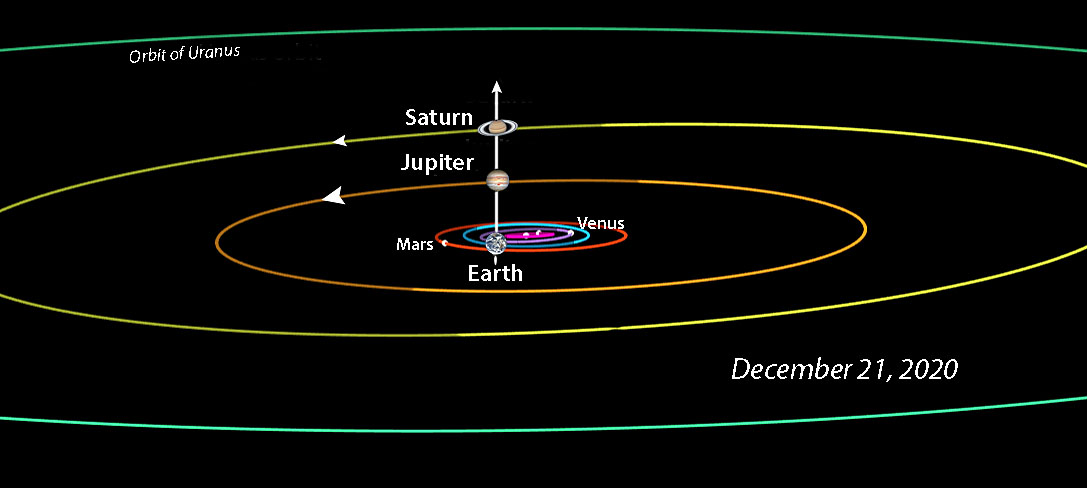
-

 jusplay4fun
jusplay4fun
- Posts: 7135
- Joined: Sun Jun 16, 2013 8:21 pm
- Location: Virginia






















Re: Astronomy!
I saw both about 6:15 local time. The Great Conjunction NEARS...!
jusplay4fun wrote:Jupiter and Saturn fashion a 21st-century version of the “Christmas Star” when they pair up on December 21st, the winter solstice. That evening they’ll be closest in nearly 400 years.
While we're all trying our best to keep our distance from one another during the current pandemic, Jupiter and Saturn are defiantly doing exactly the opposite. Since September they've been drawing closer and closer as they inch toward their Great Conjunction on Monday, December 21st. That night the gas giants will shine shoulder to shoulder just 0.1° apart (1/5th the apparent diameter of the full Moon) in their closest conjunction since July 1623.
Every 20 years, Jupiter, the closer and faster planet, laps slower Saturn and the two pair up briefly in a Great Conjunction. The last occurred on May 31, 2000, when they stood 1.2° apart low in the solar glare at dawn.
https://skyandtelescope.org/astronomy-news/jupiter-and-saturn-embrace-in-solstice-conjunction/Bright Jupiter and Saturn are closer together now (1.8° apart) than modest, 3rd-magnitude Alpha and Beta Capricorni are above them (2.3° apart), as shown below. Wait for full dark to catch the faint stars. Jupiter and Saturn are closing toward their record-breaking conjunction on December 21st, when they will appear only 0.1° apart. That's about the width of a toothpick at arm's length!
-

 jusplay4fun
jusplay4fun
- Posts: 7135
- Joined: Sun Jun 16, 2013 8:21 pm
- Location: Virginia






















Re: Astronomy!
There is a guy doing some live videos while he checks out the near conjunction of Jupiter and Saturn. He is in Northunberland or similar so he has a pretty good time for viewing. Some of the videos are better than others. I suspect he has some fun toys.
His page is called.
Wil Photography.
His page is called.
Wil Photography.
-

 2dimes
2dimes
- Posts: 12964
- Joined: Wed May 31, 2006 1:08 pm
- Location: Pepperoni Hug Spot.














Re: Astronomy!
JUPITER AND SATURN EMBRACE IN SOLSTICE CONJUNCTION
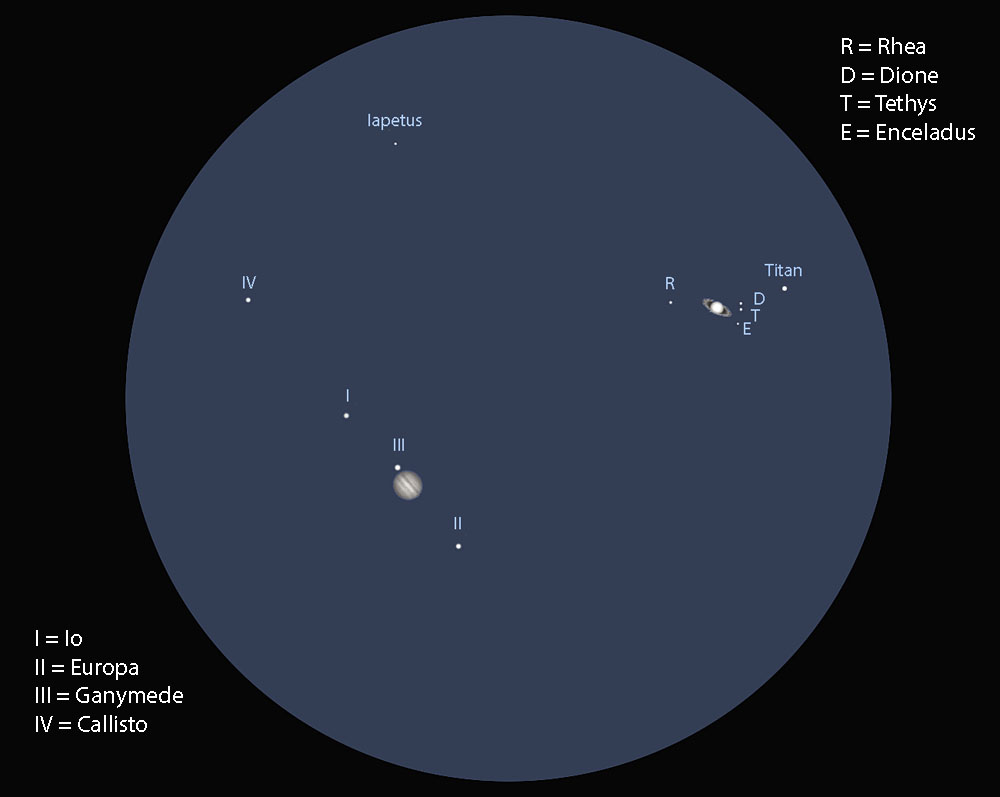
https://skyandtelescope.org/astronomy-news/jupiter-and-saturn-embrace-in-solstice-conjunction/

On the first day of fall, 7.5° or four fingers held together at arm's length, separated the two giants. On Monday, December 14th, they'll be 0.75° apart and close enough to fit together in a telescope's low-magnification field of view. Come December 21st, they'll scrunch nearly eight time closer — just 6.1′or 0.1° apart (center to center), closer than they've been in nearly 400 years! Closest approach occurs around 18h UT (1 p.m. EST). By the time the duo makes its appearance at dusk over the Americas their spread will have increased slightly to around 6.3′.
https://skyandtelescope.org/astronomy-news/jupiter-and-saturn-embrace-in-solstice-conjunction/
-

 jusplay4fun
jusplay4fun
- Posts: 7135
- Joined: Sun Jun 16, 2013 8:21 pm
- Location: Virginia






















Re: Astronomy!
I did see only one photo of near conjunction, and the 2nd is a good photo:
https://www.facebook.com/photo?fbid=201855064893006&set=pb.100052055405812.-2207520000..
https://www.facebook.com/photo?fbid=200004001744779&set=pb.100052055405812.-2207520000..
https://www.facebook.com/photo?fbid=201855064893006&set=pb.100052055405812.-2207520000..
https://www.facebook.com/photo?fbid=200004001744779&set=pb.100052055405812.-2207520000..
2dimes wrote:There is a guy doing some live videos while he checks out the near conjunction of Jupiter and Saturn. He is in Northunberland or similar so he has a pretty good time for viewing. Some of the videos are better than others. I suspect he has some fun toys.
His page is called.
Wil Photography.
-

 jusplay4fun
jusplay4fun
- Posts: 7135
- Joined: Sun Jun 16, 2013 8:21 pm
- Location: Virginia






















Re: Astronomy!
right Jupiter and distant Saturn now shine strikingly close together in the southwestern sky at nightfall. This evening they're only 1.1° apart, about the width of a pencil held at arm's length. They're closing toward a mere 0.1° apart on December 21st. That's about the width of a toothpick at arm's length!
Watch their progress each evening. Already they'll fit together in the view of most telescope eyepieces at 40 power or less.
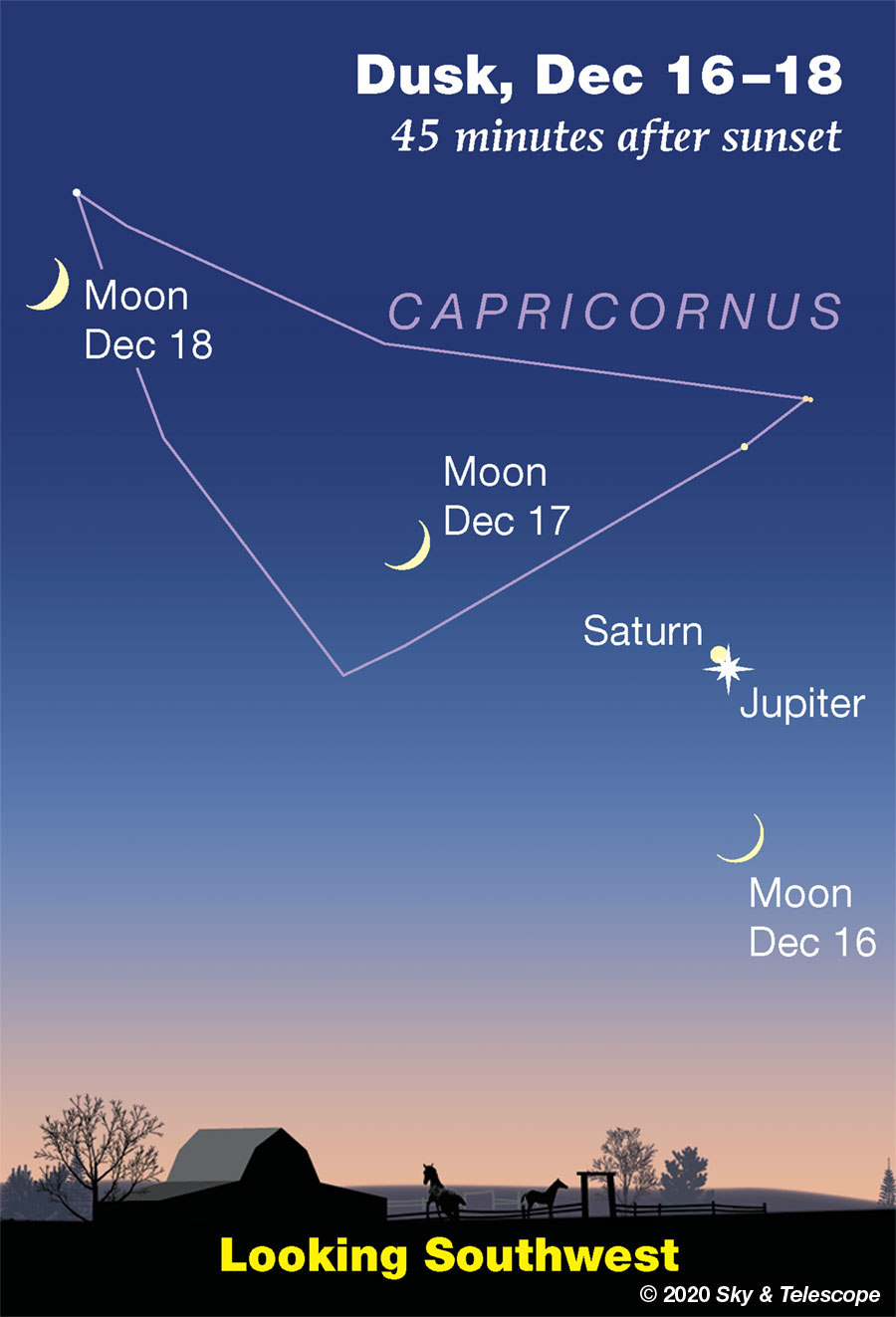
-

 jusplay4fun
jusplay4fun
- Posts: 7135
- Joined: Sun Jun 16, 2013 8:21 pm
- Location: Virginia






















Re: Astronomy!
The Great Conjunction:
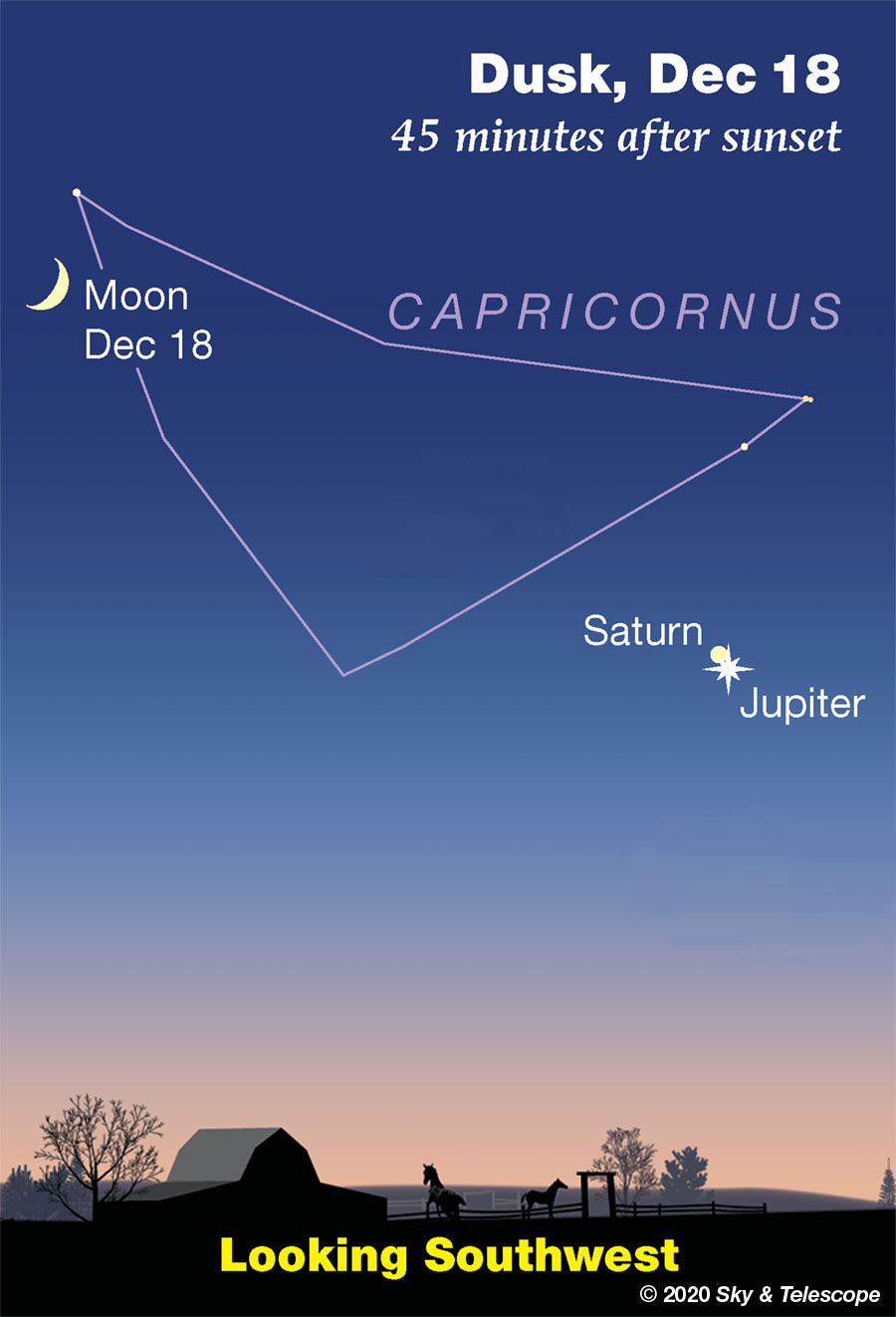
FRIDAY, DECEMBER 18
■ Jupiter and Saturn are drawing the world's attention as they creep strikingly closer together in the southwest at nightfall. This evening Saturn is only 0.3° above Jupiter, as shown below in twilight. That's hardly the width of a chopstick at arm's length. They're closing toward a mere 0.1° apart on December 21st, toothpick width! After that they widen again.

SUNDAY, DECEMBER 20
■ This is solstice night, the longest night of the year, and tomorrow is the shortest day. The exact time of the solstice is 5:02 a.m. EST Dec. 21. This is when the Sun reaches its farthest point south in the sky and begins its six-month return northward. That's the moment when winter officially begins (in the Northern Hemisphere).
■ You are remembered, Carl Sagan (November 9, 1934 – December 20, 1996).
MONDAY, DECEMBER 21
■ Shortest day of the year; see above.
■ At last, the record-breaking Jupiter-Saturn conjunction is this evening! If you have a telescope, get it on the pair of planets as early in twilight as you can find them, while they're still relatively high. See Jupiter and Saturn Embrace in Solstice Conjunction. (It's just a coincidence that this is happening on the day of the solstice.) And for more background, The 400-Year Rhythm of Great Conjunctions.
-

 jusplay4fun
jusplay4fun
- Posts: 7135
- Joined: Sun Jun 16, 2013 8:21 pm
- Location: Virginia






















Re: Astronomy!
TUESDAY, DECEMBER 22
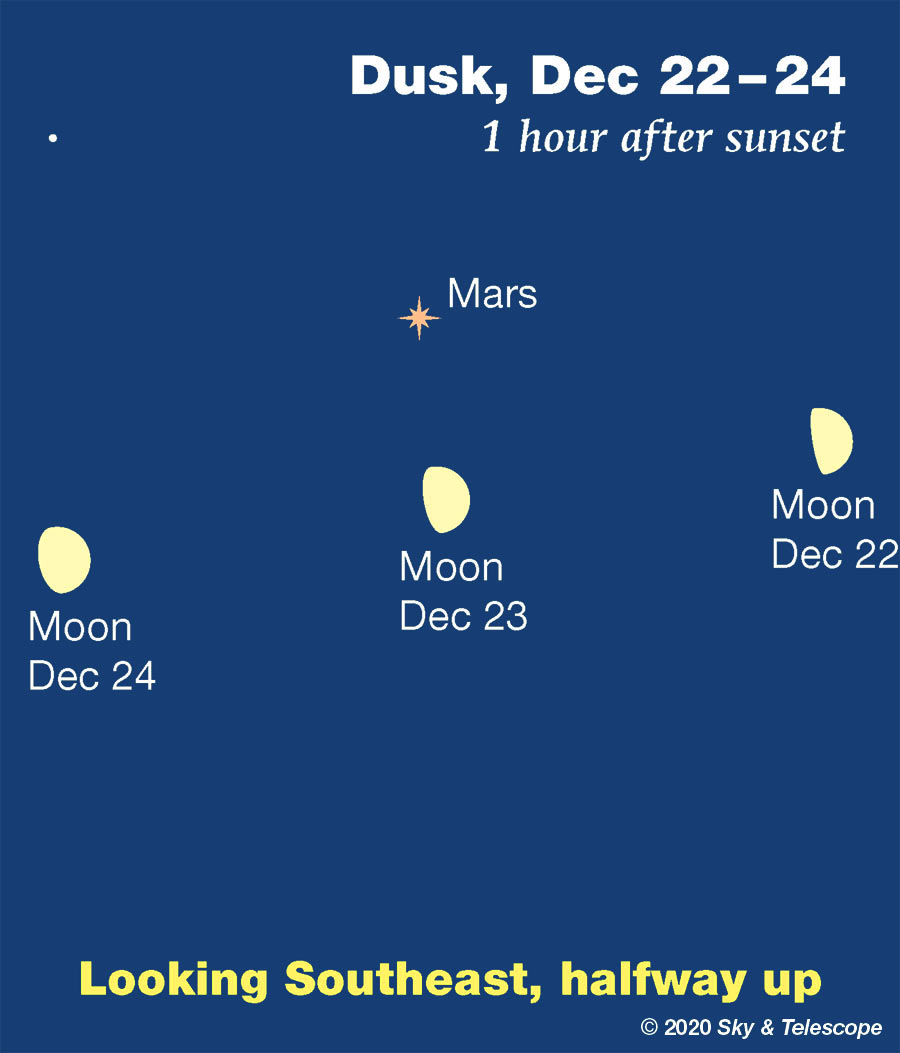
■ This evening the Moon shines lower right of Mars, as shown below. As evening advances, the line they form tilts more steeply downward. The Moon sets around 1 a.m., Mars nearly an hour later (for mid-northern latitudes).

-

 jusplay4fun
jusplay4fun
- Posts: 7135
- Joined: Sun Jun 16, 2013 8:21 pm
- Location: Virginia






















Re: Astronomy!
THIS WEEK'S PLANET ROUNDUP
https://skyandtelescope.org/observing/this-weeks-sky-at-a-glance-december-18-26/
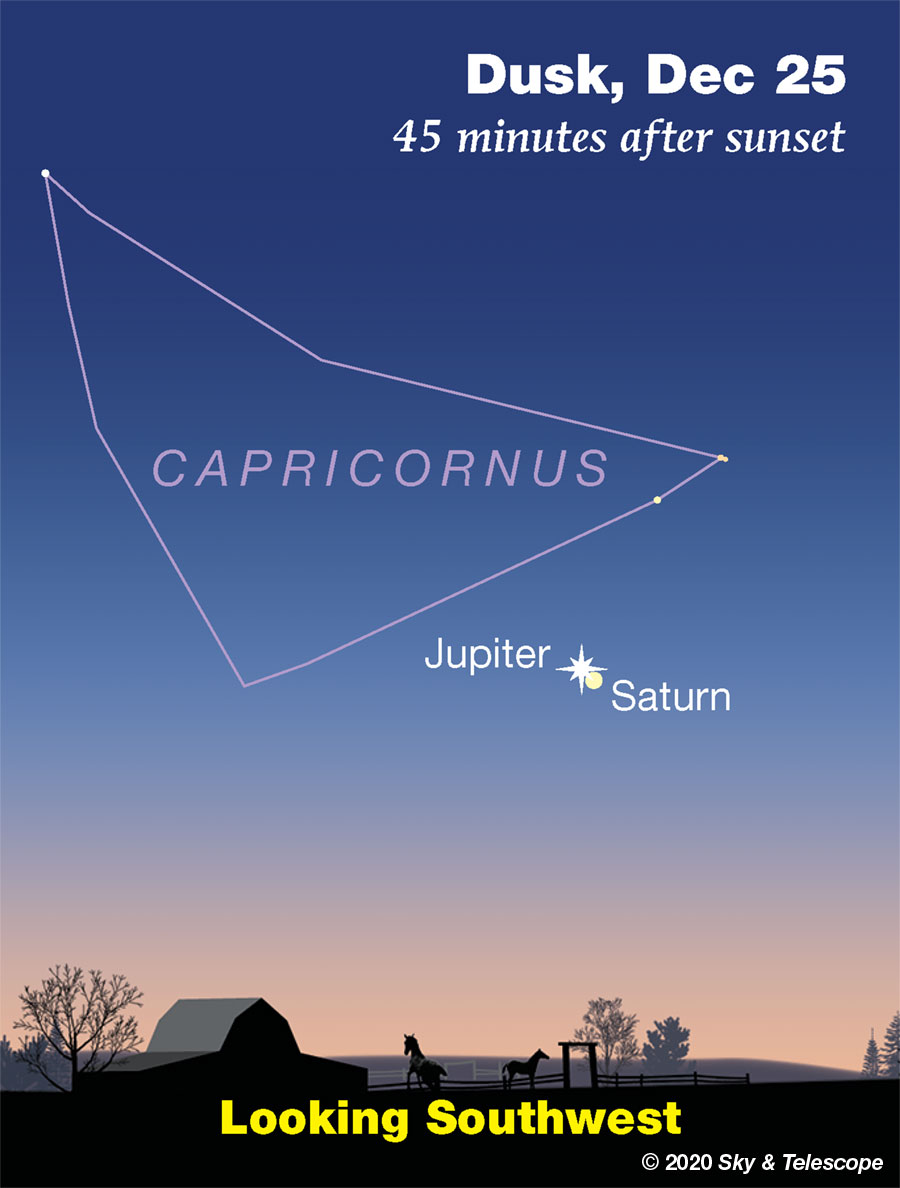
Mercury is out of sight in conjunction with the Sun.
Venus (magnitude –3.9, at the head of Scorpius) shines low in the southeast during early dawn as the "Morning Star." As dawn advances, watch it climb higher as it fades into the growing daylight.
Mars (about magnitude –0.5, in Pisces) shines bright yellow-orange very high in the south during early evening. Mars is fading and shrinking into the distance, but it's still 12 or 11 arcseconds wide in a telescope, still big enough to show some surface detail during steady seeing. It's gibbous: 90% sunlit from Earth's point of view. Its recent dust storms seem to be over.
https://skyandtelescope.org/observing/this-weeks-sky-at-a-glance-december-18-26/
THURSDAY, DECEMBER 24
■ A Christmas star-tower: This is the time of year when Orion shines in the east-southeast after dinnertime. He's well up now, but his three-star Belt is still nearly vertical. The Belt points up toward Aldebaran and, even higher, the Pleiades.
Off to the right of the Pleiades the Moon shines brightly. Orange Mars glows to the right of the Moon.
FRIDAY, DECEMBER 25

■ As Jupiter and Saturn move apart, they're sinking quite low in the southwest in twilight as shown above.
■ Algol shines at its minimum brightness, magnitude 3.4 instead of its usual 2.1, for a couple hours centered on 12:27 a.m. EST tonight; 9:27 p.m. PST. Algol takes several additional hours to fade and to rebrighten.
SATURDAY, DECEMBER 26
■ The waxing gibbous Moon shines roughly between Aldebaran and the Pleiades. Off to their left sparkles bright Capella.
-

 jusplay4fun
jusplay4fun
- Posts: 7135
- Joined: Sun Jun 16, 2013 8:21 pm
- Location: Virginia






















Re: Astronomy!
Too cloudy here to see Venus; I came in a few minutes ago:
THIS WEEK'S PLANET ROUNDUP
Mercury is out of sight in conjunction with the Sun.
Venus (magnitude –3.9, at the head of Scorpius) shines low in the southeast during early dawn as the "Morning Star." As dawn advances, watch it climb higher as it fades into the growing daylight.
-

 jusplay4fun
jusplay4fun
- Posts: 7135
- Joined: Sun Jun 16, 2013 8:21 pm
- Location: Virginia






















Re: Astronomy!
I have missed this event. Hope the technology that can make the human immortal will be invented so that I could observe the next Jupiter and Saturn connection after 700 years.
-
 cannon_gray
cannon_gray
- Posts: 2
- Joined: Tue Dec 22, 2020 3:59 am
Re: Astronomy!
I saw the Great Conjunction on the winter solstice, and on 12/22, too. I saw bright Venus early this morning.
Now to look for Mars. I may have seen it, but I was not sure what I was looking at.
Now to look for Mars. I may have seen it, but I was not sure what I was looking at.
-

 jusplay4fun
jusplay4fun
- Posts: 7135
- Joined: Sun Jun 16, 2013 8:21 pm
- Location: Virginia






















Return to Out, out, brief candle!
Who is online
Users browsing this forum: No registered users

